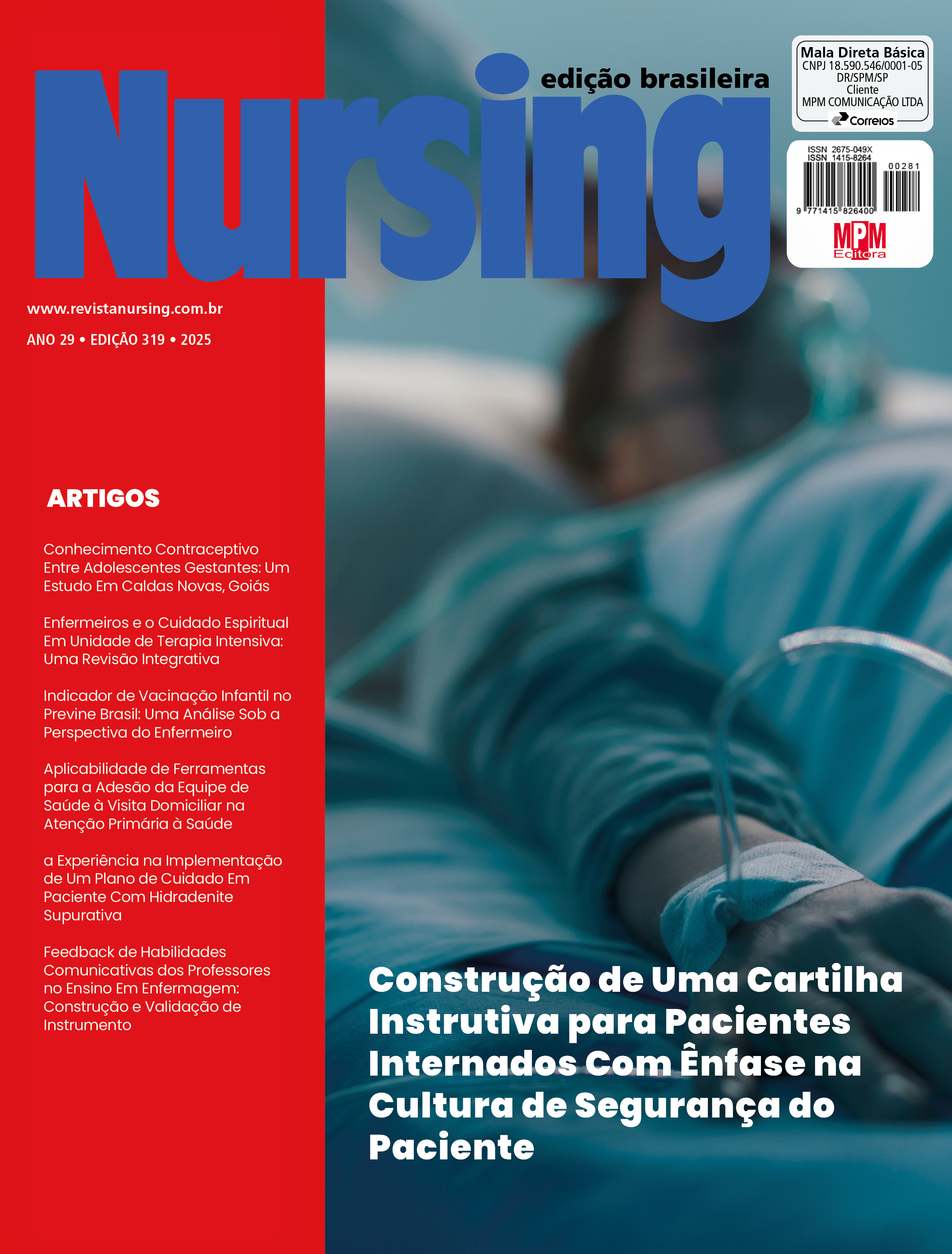Epidermolysis Bullosa: Management of Coverings
DOI:
https://doi.org/10.36489/nursing.2025v29i319p10370-10374Keywords:
Epidermolysis Bullosa, Management, CoveringsAbstract
Epidermolysis Bullosa is a rare disease, non-contagious and without cure, hereditary caused by mutations in several previous skin proteins, of different intensities that can give rise to flictenes throughout the body, the severity of which will depend on the mutation involved in the pathogenesis. The four main types: simple, junctional, dystrophic and infantile. This article aimed to evaluate the proper management, related to the use of coverings in the patients with the disease. For this, a review of all specific literature found on the topic was carried out. They were consulted as electronic bases scielo, bireme and Google Scholar in the period of March and April 2021; in addition to primary sources such as books. The material was selected according to the keywords: Epidermolysis Bullosa, causes, treatment, use of coverings; data from 2010 to 2021. The results found show that the care provided to patients with the disease, regardless of type, is nonspecific, with proper management of skin lesions according to the characteristics being considered of great importance. A rigorous assessment by the multidisciplinary team is recommended to analyze skin and extracutaneous involvement, avoiding complications such as, for example, guaranteeing a better quality of life. It is concluded that the treatment of epidermolysis Bullosa should focus on the prevention of complications, using appropriate coverage for each evolution of activities, also involving the psychological care of the patient and family, for a better understanding of the disease, thus resulting in better care.
References
BRAGA-Silva J; GERHARDT S. Epidermólise bolhosa distrófica: aspectos dermatológicos e cirúrgicos. Porto alegre, 2014, v. 58, n. 1, p. 65-8.. Disponível em Acesso em: 23/05/21.
BENÍCIO, Claudia Daniella Avelino Vasconcelos et al. Epidermólise bolhosa: Foco na assistência de enfermagem. Estima–Brazilian Journal of Enterostomal Therapy, v. 14, n. 2, 2016. Disponível em:. Acesso em: 22/05/21.
BEGA, Aline Gabriela et al. Epidermólise bolhosa: revisão de literatura. Anais Eletrônico IX EPCC–Encontro Internacional de Produção Científica UniCesumar Nov, n. 9, p. 4-8, 2015. Disponível em:file:///C:/Users/User/Desktop/Nova%20pasta/aline_gabriela_bega_1.pdf. Acesso em: 22/05/21.
Melo JN; Machado MCR; Sotto MN. Nevo da epidermólise bolhosa: aspectos clínicos, dermatoscópicos e histológicos em um caso de portador da forma distrófica recessiva. An Bras Dermatol. 2011; 86, n. 4, p. 743-746. Disponível em: < https://www.scielo.br/pdf/abd/v86n4/v86n4a17.pdf>. Acesso em: 22/05/21.
Corrêa FB, Coltro PS, Farina JA Junior. General treatment and wound management in hereditary epidermolysis bullosa: indication and experience using silver hydrofiber dressing. Rev Bras Cir Plást. 2016; 31(4): 565-572; Disponível em: < https://pesquisa.bvsalud.org/portal/resource/pt/biblio-827464>. Acesso em:23/05/2021.
Sabiá CR. Epidermólise Bolhosa: aspectos epidemiológicos e evidências sanitárias no Brasil, no período de 2009 a 2013 [trabalho de conclusão de curso]. Brasília (DF): Universidade de Brasília; 2016; Disponível em: < https://bdm.unb.br/bitstream/10483/13677/1/2016_ConsueloFerreiraSabia.pdf>. Acesso em: 22/01/21.
Hebert SK, Barros Filho TEP, Xavier R, Pardini Júnior AG. Ortopedia e Traumatologia: Princípios e prática. 5 ed. São Paulo: Artes médicas; 2016. p.460; Acesso em: 23/05/21.
Jain SV, Murrell DF. Psychosocial impacto f inherited and autoimune blistering diseases. Intern J Wom Dermatol. 2018 Mar; 4(1): 49-53; Disponível em:< file:///C:/Users/User/Downloads/1-s2.0-S2352647518300078-main.pdf>. Acesso em: 23/05/21.
Intong LR, Murrel DF. Inherited epidermolysis bullosa: new diagnostic criteria and classification. Clin Dermatol. 2012; 30(1): 70-77; Disponível em: < file:///C:/Users/User/Downloads/1-s2.0-S0738081X11000885-main.pdf>. Acesso em: 22/05/21.
Brasília. Secretaria de Saúde do Distrito Federal. Portaria 29, 1 de mrço de 2016. Aprova os Protocolos Clínicos e de Dispensação de Medicamentos elaborados pelas áreas técnicas de SES-DF e aprovados pela CPPAS. Diário Oficial do Distrito Federal. 2016 Mar 03. p 10; Disponível em: < file:///C:/Users/User/Desktop/Nova%20pasta/Rev-Juridica-PG-DF_v.42_n.1.pdf>. Acesso em: 22/01/21.
Lowy G, Cestari CP, Cestari TF, Oliveira ZNP. Atlas topográfico de dermatologia
pediátrica, do diagnóstico ao tratamento. Rio de Janeiro: Revinter; 2013. 376 p;
Loureiro RJ, Roque F, Rodrigues AT, Herdeiro MT, Ramalheira E. O uso de
antibióticos e as resistências bacterianas: breves notas sobre sua evolução. Rev
Port Saúde Públ. 2016 Jan-Abr; 34(1): 77-84; Disponível em:< file:///C:/Users/User/Downloads/2657-10489-1-PB.pdf>. Acesso em: 22/01/21.
Oliveira ZNP, Périgo AM, Fukumori LMI, Aoki V. Immunological mapping in hereditary epidermolysis bullosa. An Bras Dermatol [Internet]. 2010; Disponível em: < https://www.scielo.br/pdf/abd/v85n6/en_v85n6a12.pdf>. Acesso em: 23/05/21.
Borges EL, Dias CA. Recomendações para prevenção e tratamento de lesões de pele decorrente de epidermólise bolhosas. Ver Enferm Atual in Derme. 2013. Disponível em: < http://formsus.datasus.gov.br/novoimgarq/51534/11111095_345331.pdf>. Acesso em:23/05/21.








